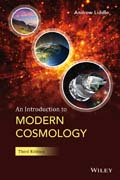
An Introduction to Modern Cosmology Third Edition is an accessible account of modern cosmological ideas. The Big Bang Cosmology is explored, looking at its observational successes in explaining the expansion of the Universe, the existence and properties of the cosmic microwave background, and the origin of light elements in the universe. Properties of the very early Universe are also covered, including the motivation for a rapid period of expansion known as cosmological inflation. The third edition brings this established undergraduate textbook up–to–date with the rapidly evolving observational situation.This fully revised edition of a bestseller takes an approach which is grounded in physics with a logical flow of chapters leading the reader from basic ideas of the expansion described by the Friedman equations to some of the more advanced ideas about the early universe. It also incorporates up–to–date results from the Planck mission, which imaged the anisotropies of the Cosmic Microwave Background radiation over the whole sky. The Advanced Topic sections present subjects with more detailed mathematical approaches to give greater depth to discussions. Student problems with hints for solving them and numerical answers are embedded in the chapters to facilitate the reader’s understanding and learning.Cosmology is now part of the core in many degree programs. This current, clear and concise introductory text is relevant to a wide range of astronomy programs worldwide and is essential reading for undergraduates and Masters students, as well as anyone starting research in cosmology. Supplementary material, including full–colour images, updates and links for students and instructors, is available on the author’s website: http://www.roe.ac.uk/?arl/. INDICE: Preface xiConstants, conversion factors and symbols xiv1 A (Very) Brief History of Cosmological Ideas 12 Observational Overview 32.1 In visible light 32.2 In other wavebands 62.3 Homogeneity and isotropy 102.4 The expansion of the Universe 102.5 Particles in the Universe 133 Newtonian Gravity 213.1 The Friedmann equation 223.2 On the meaning of the expansion 253.3 Things that go faster than light 253.4 The fluid equation 263.5 The acceleration equation 273.6 On mass, energy and vanishing factors of c2 284 The Geometry of the Universe 294.1 Flat geometry 294.2 Spherical geometry 304.3 Hyperbolic geometry 324.4 Infinite and observable Universes 334.5 Where did the Big Bang happen? 334.6 Three values of k 345 Simple Cosmological Models 375.1 Hubble s law 375.2 Expansion and redshift 385.3 Solving the equations 395.4 Particle number densities 435.5 Evolution including curvature 446 Observational Parameters 496.1 The expansion rate H0 496.2 The density parameter 0 516.3 The deceleration parameter q0 527 The Cosmological Constant 557.1 Introducing — 557.2 Fluid description of — 567.3 Cosmological models with — 578 The Age of the Universe 619 The Density of the Universe and Dark Matter 679.1 Weighing the Universe 679.2 What might the dark matter be? 739.3 Dark matter searches 7410 The Cosmic Microwave Background 7710.1 Properties of the microwave background 7710.2 The photon to baryon ratio 7910.3 The origin of the microwave background 8010.4 The origin of the microwave background (advanced) 8311 The Early Universe 8712 Nucleosynthesis: The Origin of the Light Elements 9312.1 Hydrogen and Helium 9312.2 Comparing with observations 9612.3 Contrasting decoupling and nucleosynthesis 9813 The Inflationary Universe 10113.1 Problems with the Hot Big Bang 10113.2 Inflationary expansion 10513.3 Solving the Big Bang problems 10613.4 How much inflation? 10813.5 Inflation and particle physics 10914 The Initial Singularity 11315 Overview: The Standard Cosmological Model 117Advanced Topic 1 General Relativistic Cosmology 1211.1 The metric of space–time 1211.2 The Einstein equations 1221.3 Aside: Topology of the Universe 124Advanced Topic 2 Classic Cosmology: Distances and Luminosities 1272.1 Light propagation and redshift 1272.2 The observable Universe 1302.3 Luminosity distance 1302.4 Angular diameter distance 1342.5 Source counts 136Advanced Topic 3 Neutrino Cosmology 1393.1 The massless case 1393.2 Massive neutrinos 1413.3 Neutrinos and structure formation 142Advanced Topic 4 Baryogenesis 145Advanced Topic 5 Structures in the Universe 1495.1 The observed structures 1495.2 Gravitational instability 1515.3 The clustering of galaxies 1525.4 Cosmic microwave background anisotropies 1545.5 The origin of structure 159Advanced Topic 6 Constraining cosmological models 1636.1 Cosmological models and parameters 1636.2 Key cosmological observations 1646.3 Cosmological data analysis 1646.4 The Standard Cosmological Model: 2014 edition 1666.5 The future 168Bibliography 171Numerical answers and hints to problems 173Index 177
- ISBN: 978-1-118-50209-9
- Editorial: Wiley–Blackwell
- Encuadernacion: Cartoné
- Páginas: 200
- Fecha Publicación: 27/03/2015
- Nº Volúmenes: 1
- Idioma: Inglés
